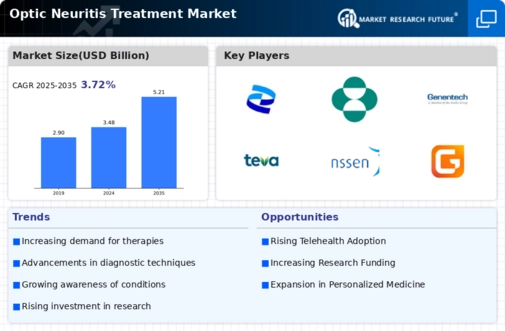Market Trends and Projections
This section includes charts illustrating the growth trajectory of the Global Optic Neuritis Treatment Market Industry, highlighting key metrics such as market value projections for 2024 at 3.48 USD Billion and 5.21 USD Billion by 2035. Additionally, the compound annual growth rate of 3.73% from 2025 to 2035 is depicted, showcasing the anticipated expansion of the market driven by various factors including treatment advancements and increasing prevalence.
Advancements in Treatment Modalities
Innovations in treatment options for optic neuritis are significantly influencing the Global Optic Neuritis Treatment Market Industry. Recent developments include the introduction of monoclonal antibodies and corticosteroids, which have shown efficacy in reducing inflammation and promoting recovery. For instance, intravenous methylprednisolone is commonly utilized in acute cases, demonstrating a positive impact on visual outcomes. As these treatment modalities evolve, they are likely to enhance patient outcomes and satisfaction. The market is expected to reach 5.21 USD Billion by 2035, reflecting the potential for continued advancements in therapeutic strategies.
Increasing Prevalence of Optic Neuritis
The Global Optic Neuritis Treatment Market Industry is experiencing growth driven by the rising incidence of optic neuritis, particularly among younger populations. This condition is often associated with multiple sclerosis, which has been reported to affect approximately 2.3 million individuals worldwide. As awareness of optic neuritis increases, more patients seek treatment, contributing to market expansion. The projected market value for 2024 is estimated at 3.48 USD Billion, indicating a robust demand for effective therapies and interventions. This trend suggests that healthcare providers will need to enhance their treatment offerings to accommodate the growing patient population.
Growing Awareness and Education Initiatives
The Global Optic Neuritis Treatment Market Industry benefits from increasing awareness and educational initiatives aimed at both healthcare professionals and the general public. Campaigns led by health organizations and patient advocacy groups are crucial in disseminating information about optic neuritis symptoms, diagnosis, and treatment options. This heightened awareness may lead to earlier diagnosis and intervention, ultimately improving patient outcomes. As the market evolves, the emphasis on education is likely to drive demand for innovative treatments, contributing to a projected compound annual growth rate of 3.73% from 2025 to 2035.
Increasing Research and Development Activities
The Global Optic Neuritis Treatment Market Industry is bolstered by a surge in research and development activities focused on understanding the underlying mechanisms of optic neuritis and exploring novel therapeutic approaches. Academic institutions and pharmaceutical companies are collaborating to investigate potential treatments, including neuroprotective agents and regenerative therapies. These efforts are likely to yield new treatment options that could significantly alter the management of optic neuritis. As R&D continues to advance, the market is poised for growth, with innovative therapies expected to emerge in the coming years.
Rising Investment in Healthcare Infrastructure
Investment in healthcare infrastructure is a pivotal driver for the Global Optic Neuritis Treatment Market Industry. Governments and private sectors are increasingly allocating resources to enhance diagnostic and treatment facilities, particularly in developing regions. Improved access to healthcare services enables timely diagnosis and treatment of optic neuritis, which is essential for preventing long-term complications. This trend is expected to support the market's growth trajectory, as enhanced infrastructure facilitates the introduction of advanced treatment options and technologies, thereby improving patient care and outcomes.














